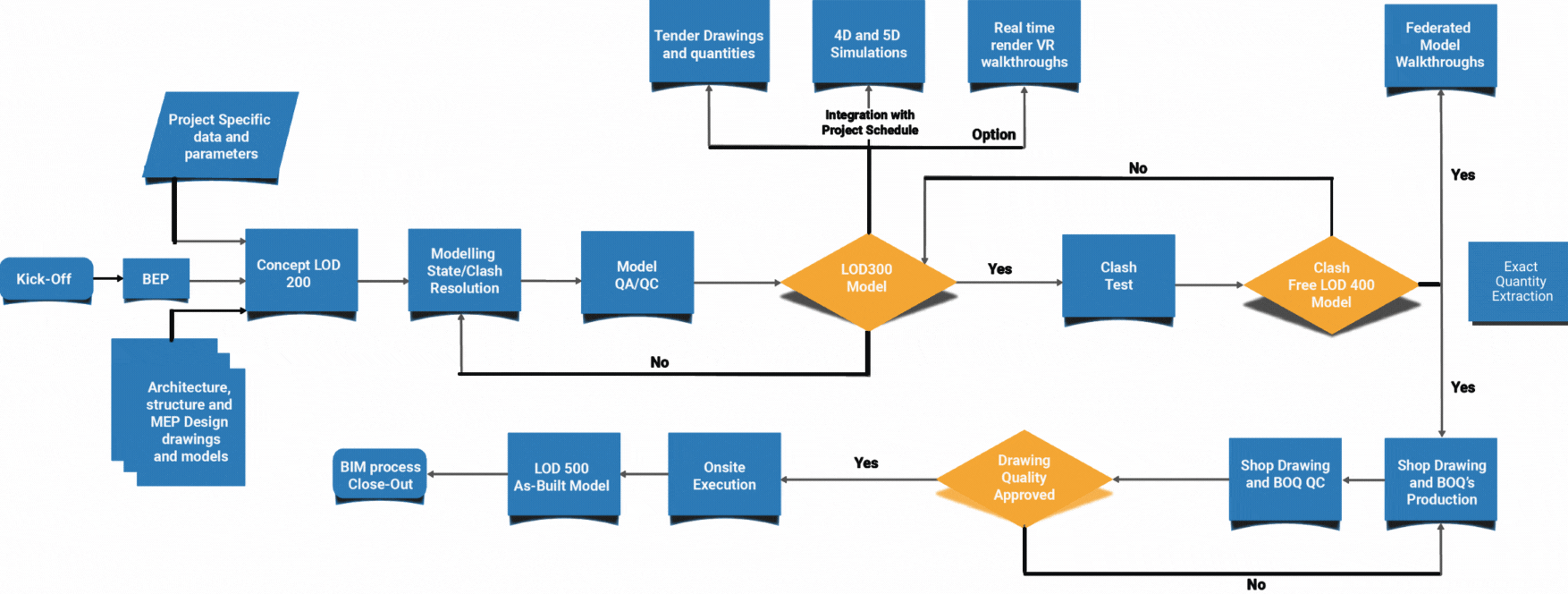
Building information modelling (BIM) methodology enables project stakeholders to create information-rich virtual models that help better to visualize building projects. There is currently a shift in the AEC (Architecture, Engineering, and Construction) industry to embrace BIM as a tool that can assist in integrating the fragmented industry by eliminating inefficiencies and redundancies, improving collaboration and communication, and enhancing overall productivity.
BIM is defined as the process of creating building information, stored in a centralized virtual model that can be managed allowing exchanging and sharing building data in an interoperable and reusable way. BIM concerns the process of development of a computer-generated model representing all disciplines of a building design, and its use in several tasks as design simulation, construction planning, or facilities management. The resulting product, a Building Information Model, is a data-rich, intelligent and parametric digital representation of the building project. So, as a first perspective, the result of BIM methodology can not only be considered as a virtual representation of a building, an object-oriented three-dimensional (3D) model, but is also a repository of project data.
The BIM data-model can be easily accessed, facilitating interoperability and exchange of project data with related software applications. BIM in short is a highly collaborative process that allows architects, engineers, real estate developers, contractors, manufacturers, and other construction professionals to plan, design, and construct a structure or building within one 3D model.
Using BIM (Virtual Design and Construction), our team will search for and select alternatives that meet all project requirements. Discovering and solving these issues at an early stage would save time, eliminate rework, improve quality and allow everyone on the project team to be successful.
The effective application of BIM will reap benefits throughout the construction life cycle of the project from the initial pre-construction stage to during construction and use. Our approach to virtual design and construction with BIM will create the opportunity to identify problems earlier in the building process and facilitate teams to rethink traditional roles and find better and faster ways to communicate ideas, reducing errors and improving productivity.
Our method of work ensures that information relating to design and construction activities flow seamlessly between all stakeholders involved in the project through the simple exchange of models and data, so that team members can ensure that information is complete and accurate. This can deliver a range of benefits, including simplified product cdsa`selection, elimination of the need to switch between 2D and 3D modeling, robust design solutions, automatic clash avoidance and more effective team working across the project’s supply chain.
Because BIM uses computer animation and 3D model fly-throughs to enhance the visualisation of a project, clients are able to better understand the build, both from a performance perspective and the user’s own experience. As a result, better-informed decision-making is possible even at this early stage, along with a marked amount of collaboration between the client, design team and other stakeholders.
The user-friendly, easily-understandable approach allows clients to hit occupancy and sales targets, while quantity surveyors can take area information from the model and more readily calculate a design cost in a quicker manner. The visualisation techniques of BIM employ conflict detection, allowing design errors to be spotted and amended before it’s too late. At the pre-construction phase, BIM can keep cost savings down and reduce waste, which reduces the possibility of cost risks and missed deadlines in the process. This is due to parametric modelling, which involves the use of a relational database containing information regarding the elements of a structure and their relationships. As a result, it’s possible to carry out a high level of model analysis, encompassing everything from the generation of space calculations, energy efficiency, structural analysis details and traditional design document. The risk of incorrect measurements or inaccurate costs will therefore be markedly reduced.
As the project moves towards the construction phase, BIM’s cloud connectivity capabilities mean information accrued over the course of the project can be accessed whenever it needs to be at a later stage. And because everyone has access to this information, whether it’s in the form of an audit trail, progress report or interim certificate analysis, all members of the project stay up-to-date in a timely and relevant manner. BIM can also provide visual risk analysis for safety evaluations. These detailed reports demonstrate site conditions, which is an excellent way for new construction workers to familiarise themselves with the worksite. The fine-tuned details that relate to specific tasks mean that construction managers can avoid hazards from the outset of the construction process.
Even after a project has finished, the cost of operating still presents significant risk. At both the design and construction phase, information has to be collected to allow for comparisons between actual performance and predicted performance. By linking the BIM model to a computed facility management system, data can be recorded so those managing the facility to identify areas of efficiency and inefficiency.
Because the opportunity for errors can potentially decline, BIM can help to increase the construction efficiency. Additionally, the BIM originally used acts as a handy foundation later down the line; once it’s in place, a new contractor is able to step in and improve on a building in a smoother, more streamlined manner.